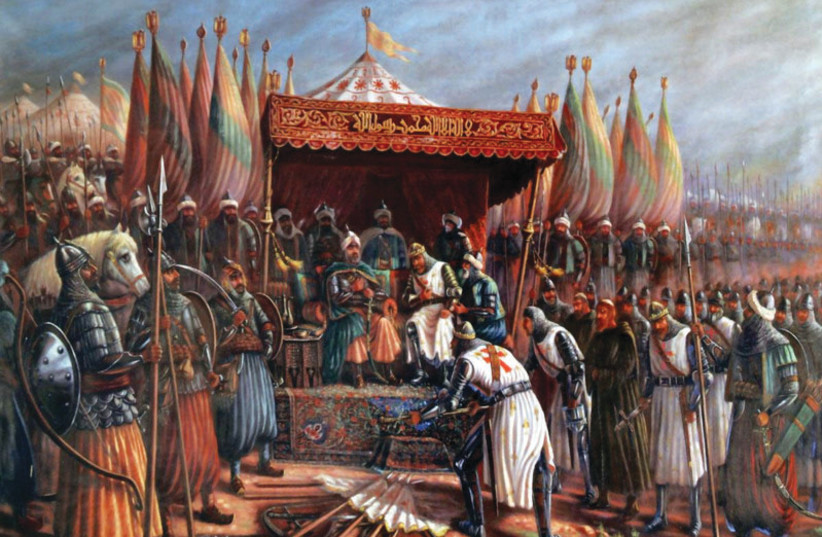Stefan Hertmans’ historical novel The Convert centers on the love story between a Christian girl and a Jewish boy in France in an age dominated by a dogmatic Christianity which barely tolerated the Jews living among them.
Vigdis Adelais Gudbrandr, a Norman-Flemish woman from a noble family in Rouen, falls in love with David Todros, the son of the rabbi in Narbonne. She converts to Judaism to marry him and becomes Sarah Hamoutal Todros. Hamoutal means “warm dew” in Hebrew.
Pursued by her father’s knights in a time of rising antisemitism leading to the First Crusades, Hamoutal and David flee to Monieux in Provence. Later, Hamoutal travels to Cairo and back.
The truth behind the fiction: An interfaith love story
Although developed by the author’s creative imagination, the book is inspired by a true story and backed with extensive research, such as two documents relevant to Hamoutal that Hertmans discovered in the Cairo Genizah – the burial place of hundreds of thousands of fragments of Jewish history.
Hertmans owns a summer house in the picturesque French village of Monieux. Fascinated by medieval ruins only 200 meters from his home, he was eventually to incorporate local information he gleaned locally into the plot of his book.

These ruins were the remains of buildings that existed outside the center of the medieval village yet still inside the defense walls that had surrounded it. He heard rumors about a hidden Jewish treasure and a Jewish cemetery in the village.
A neighbor showed him the steps in a water hole, which Hertmans identified as the remnant of a mikveh (ritual bath).
The Convert took off in earnest when, much later, a neighbor handed him a research paper simply called “Monieux,” published in 1969 by American historian and multilingual scholar Norman Golb. Golb became an important source for the book’s historical background.
There are scholars who doubt the existence of a Jewish community in the village, believing the name Monieux to have been confused with Muño (a village close to Najera in northern Spain), since both place names are spelled the same in Hebrew. Nevertheless, while acknowledging the validity of this linguistic doubt, Hertmans is certain that Monieux is the place where the young couple lived.
“Assessing all arguments for and against, I’m convinced that Monieux is the place and that French crusaders attacked the Jewish community there.”
For Hertmans, “You need to be close to the place and live in Monieux to understand it.”
The book also follows the author’s own journey as he attempts to retrace the couple’s footsteps through modern France. However, while his reconstruction of their path is well documented and interesting, he cannot be sure of the exact route Hamoutal and David followed on their 900 km. trek from Rouen to Monieux.
Hertmans explores Rouen, where street names are still reminiscent of its Jewish past. An intact yeshiva with a Hebrew inscription on its porch was uncovered in a cellar beneath the current courthouse. A local Christian girl could easily have met a student from that yeshiva in the street – as described in the book.
Their relationship exposes her to great danger, but Hamoutal is prepared to sacrifice everything from her previous life. David teaches her Hebrew and how to pray as he gradually introduces her to Judaism. She is welcomed and accepted by his family.
“When writing the book, I felt that I was living intimately with the girl,” Hertmans explains.
He depicts Hamoutal as torn between Christianity and Judaism, unsure about the difference between them and what to believe in. In times of distress, he has her often returning to the Christian prayers of her childhood.
“Did Hamoutal ask herself if there is one true God? Or did she feel that she must adhere to something because of all her suffering? I might have given her some of my own religious doubts,” he says.
For Hertmans, the book is “above all a pledge for religious tolerance.”
On the subject of the happily-ever-after of many mixed-religion marriages or the possibility of a convert becoming trapped by changing religions for a marriage that might not last forever, Hertmans’ view is succinct and open-ended.
“There is no general rule, and situations differ,” he says.
Nevertheless, he believes that “parents of different religions, with children who fall in love with each other as in my book, should be tolerant and accept them. It’s their decision and happiness.”
Hertmans considers that The Convert, originally published in Dutch in 2016 and in English in 2020, “can also be read as a book about the eternal refugee looking for a safe place, which is more relevant than ever today.”
The Convert
By Stefan Hertmans
Pantheon
304 pages; $27.95
